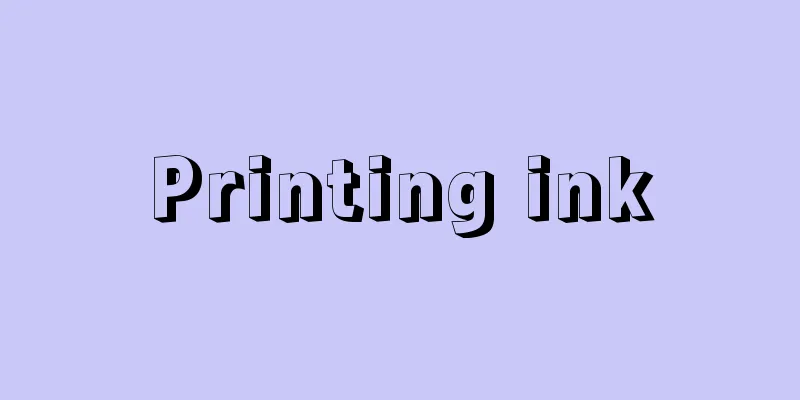Printing ink

|
A general term for inks used in printing. Pigments are mixed thoroughly with vehicles (also called mediums or vehicles) and finely dispersed to create ink. Vehicles are transparent liquids made by dissolving oils, solvents, resins, etc., and are materials that give ink the fluidity required for printing and allow it to dry quickly after printing to form a strong ink film. Pigments are colorants that do not dissolve in water, and carbon black, phthalocyanine blue, benzidine yellow, brilliant carmine 6B, lake red C, titanium white, etc. are commonly used for printing inks. Brass powder is used for gold, and aluminum powder for silver. Small amounts of auxiliary agents are also added to printing inks to adjust the drying speed and printability. The ingredients and properties of printing inks vary greatly depending on the printing method and the material being printed. Depending on the printing method, there are newspaper ink, scrap ink, letterpress rotary ink, flexographic ink (all for letterpress printing), sheet-fed offset ink, offset rotary ink, lithographic newspaper ink (all for lithographic printing), gravure ink, intaglio ink (all for intaglio printing), screen ink, mimeograph ink (all for stencil printing), magnetic ink, resist ink used for printed wiring, conductive ink, etc. Although paper is the main material to be printed, there are various materials such as plastic, cloth, metal, and glass, so ink with a suitable composition is required. Therefore, it is fundamentally different from writing ink. Fast-drying inks that meet the increasing printing speed, such as ink that dries instantly with ultraviolet light (UV ink), water-based gravure ink and ink using vegetable oil to eliminate environmental pollution, and fabric heat transfer ink are in practical use. [Fumio Hiraishi and Ryutaro Yamamoto] [Reference items] | | | | |Source: Shogakukan Encyclopedia Nipponica About Encyclopedia Nipponica Information | Legend |
|
印刷に使われるインキの総称。顔料(がんりょう)をビヒクル(ビークル)vehicle(媒質または展色料(てんしきりょう)ともいう)といっしょに十分練り合わせて細かく分散させてつくる。ビヒクルは油、溶剤、樹脂などを溶かし合わせてつくった透明な液で、印刷に必要な流動性をインキにもたせ、印刷後は速やかに乾いてじょうぶなインキ膜を形成するための材料である。顔料は水に溶けない色料で、カーボンブラック、フタロシアニンブルー、ベンジジンイエロー、ブリリアントカーミン6B、レーキレッドC、チタンホワイトなどが印刷インキ用として多く使われている。また、金色には真鍮(しんちゅう)粉、銀色にはアルミ粉が用いられる。印刷インキにはこのほか、乾燥性や印刷適性を調節するため、少量の助剤が加えられる。印刷インキは印刷方式、印刷される材料によって成分や性質が大幅に異なる。印刷方式により新聞インキ、端物(はもの)インキ、凸版輪転インキ、フレキソインキ(以上凸版印刷用)、枚葉オフセットインキ、オフ輪(オフセット輪転機)インキ、平版新聞インキ(以上平版印刷用)、グラビアインキ、凹版インキ(以上凹版印刷用)、スクリーンインキ、謄写版インキ(以上孔版印刷用)、そのほか磁気インキ、プリント配線などに使うレジストインキ、導電性インキなどもある。印刷される材料は紙が主体であるが、プラスチック、布、金属、ガラスなどさまざまであるから、それに適応した組成のインキが必要である。したがって筆記インキとは根本的に異質のものである。印刷速度の上昇にこたえる速乾性インキ、たとえば紫外線で瞬時に乾くインキ(UVインキ)、環境汚染をなくすための水性グラビアインキや植物油使用のインキ、布地熱転写インキなどが実用化されている。 [平石文雄・山本隆太郎] [参照項目] | | | | |出典 小学館 日本大百科全書(ニッポニカ)日本大百科全書(ニッポニカ)について 情報 | 凡例 |
<<: Printing machine - Insatsuki
>>: Printing - Insatsu (English spelling) printing
Recommend
Midhat Paşa
1822‐84 A politician who played a major role in th...
Edodokoro - Edodokoro
...It is found in Japan and central and southern ...
Wood sorrel - Wood sorrel
…An aquatic fern with leaves similar to wood sorr...
Yasuyuki Matsui
Year of death: January 23, 1612 (February 24, 1612...
climbing rope
...An exercise method aimed at developing a healt...
Capuchin Monkey - Omakizaru
In a broad sense, it is a general term for animal...
Bay oil (English spelling)
…The leaves of this plant are distilled with rum ...
Canal - Unga (English spelling) canal
A canal is an artificial waterway built for navig...
Katsukawa Shuncho
Date of birth and death unknown. Ukiyo-e artist o...
Precision
The degree of accuracy of a ruler or measuring in...
Hofmusik; court music
Music performed at the imperial court under the pr...
Appar (English spelling)
One of the Shaivite religious poets, also known as...
Didelphidae
…Also known as the timber rat or the opossum. A g...
Prabhāvatī (English spelling)
…He continued his father's conquests, advance...
Molisch, H.
…This term was proposed by Hans Molisch (1856-193...



![Mujtahid (English spelling) [Arabic]](/upload/images/67ccfb14e5458.webp)





